Pearl Guide Forum Member, Kelluvpearls, made a visit to Fiji Savusavu to visit Fiji Pearls and created a thread to document her trip. To our delight, Justin Hunter of Fiji Pearls, joined the forum and shared a wealth of information on her thread.
Follow along as Justin describes pearl farming in Fiji through photographs and descriptions (taken from many of his Pearl-Guide posts):
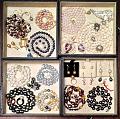
Our shells - where the magic starts.
Our oyster is a different sub species then what is used in Tahiti. Much smaller numbers of shells - but our colours are just funky. (Actually Dr. Paul Southgate looking at the genetics of our oyster - it is unique, official findings about a year away.)
It is not easy farming pearls in Fiji.
Some of the more dramatic shells we get in.
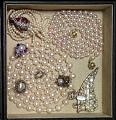
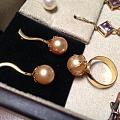
-----------
Our Chocolate Diva
This particular pearl really stood out in our last harvest. Satin finish - large size (15mm x 17mm). Makes me smile.
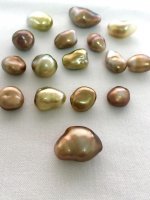
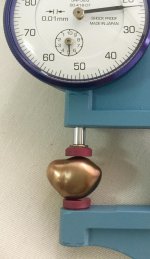
Our first operation pearls average between 10.5 and 11 mm.
Because we push size we end up with circles - but they are gorgeous circles and we get a great price for them. Ill post some of our sexy circle pearls.
-----------
These shots were taken a couple years ago in Hong Kong with Jorg Gellner.
Our circles - (which some farms try not to produce) have the best colours and lustre!
These would be our "high" 10 - 11 mm rounds and circles.
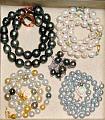
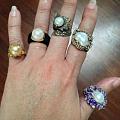
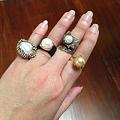
-----------
The story of pearls.
We had a photographer here for the last week. Photographer got some great shots with drone. This is our hatchery - below.
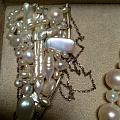
Harvesting spat collectors.
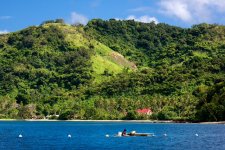
Not only is income derived from pearling but also food. When we harvest our spat collectors - women usually follow behind our barge (on bamboo rafts). She is collecting edible seaweed and other shellfish. Pearling done properly is a vital industry in our rural communities.

Part of the farm - photographer looking to see how best to capture the beauty. Beautiful pearls come from some of the most beautiful places in the world. Provides income and gives value to a pristine environment.

-----------
I must admit I spent quite a bit of time reading through the Pearl Forum last night. Thoroughly impressed with some of the technical knowledge. I can definitely assist with some insight in what we produce in Fiji and why:
Fiji Oysters are very special.
Oyster supply is Fiji?s greatest constraint, It Is also its greatest asset. The size and nacre color of our oysters are key to our industry, being able to use these unique characteristics gives Fiji Pearls a special niche in the pearling world.
There are 7 different varieties of the ?Black lipped Pearl Oyster? found in the Indo ? Pacific Oceans.
In the South Pacific there are two varieties:
Justin?s summary:
Basically we don?t have many oysters but we have:
According to Professor Paul Southgate, a regional expert on sustainable tropical aquaculture at the University of the Sunshine Coast in Queensland, Australia, ?Fiji oysters naturally show a unique blend of characteristics not found in other populations.?
- We have been working with his students for the last couple of years, specifically genetics of our oysters.
-----------
Our farming models are different and our environment can be unforgiving. With that said, in a normal year we will harvest 35 - 40% "export grade" pearls. This is exceptionally low compared to other producers. Re-seeds will range between 10 - 20% of what we implant the previous year. We always have 4th op oysters on the farms. We have even implanted a handful of oysters 7 times! (these end up in our hatchery).
Our Colours.
I would like to say that all our pearls are chocolate and distinctly Fiji - but the truth is they are not. The technician and selected mantle tissue is critical. We use three Japanese technicians - each with over 30 years experience. Two have worked for me 15 and 12 years respectively. The 3rd - worked with us for 5 years - and I just had to let him go!!!!! Why - he could not pull the colours - too much Traditional Tahitian and silver. I have tried other technicians - disaster!! Unviable.
I can glance at a bag of harvested pearls during our harvest and know which tech made them!!!
Another nuance to our colours is that every year, every season we see slight difference in overall colours.
One point that I always try to make is that our farms are located in bays around high (relative) tropical islands. We can get pretty significant rain events that can create a huge influx of nutrients via run-off and rivers. Nutrients coming into a bay in the tropics means you are going to have a food explosion!!
Most years things are fine. But this nutrient influx, can also lead to disaster. The algal profile (food available to pearl oysters) can change quickly. Unfortunately the fastest growing algae are quite often the least nutritional. It seems that about every 5 or 6 years we see a "complete crash" of young oysters on our farms. I theorise this to be food related - either low nutritional value or even slightly toxic blooms - that kill off young oysters and stress our large shells, but does not kill them - but we do see a "decrease" in colour intensity and a high % of oysters dropping pearls way later then they should be.
Also your bacterial load (vibrio) spikes - the coup de gras. And suspended particlate matter jumps. Researchers say Pearl oysters cannot handle this, but Fiji shells can.
This year instead of 35 - 40% "export grade" - we were less then 5%). This was due to a food issue in late 2012 - early 2013. Lots of those young oysters died that year - the ones that did survive, were very weak. If young oysters are stressed - their immune systems are compromised for ever! We knew this - but 5% is better then nothing, and we focus on our own retail.
I'm not a deeply religious man - but every 5 or 6 years I spend a lot of time talking to God!!!! On the positive side - I think we can manage these events better in the future.
-----------
Just a couple more pics to get my point across from earlier. I know some of you are not quite sure.
My opinion: we make the best pearls in the world. And they are not Tahitian. And this is not my doing - Tahiti lobbied and brought in researchers for years to tell everyone that their oysters and environment were special and no one else can produce what they do - which it was and is true (P m cumungi).
Then they turned around and sold their industry to mass production - cheap Chinese labour and techs. Don't even know if any locals even work in the industry anymore (bit of a joke - but also truth to this). I hate what they have done, and I feel horrible for people like Josh (Kamoka Pearls) - who gets pushed out of what they love doing, because people pushed quantity over quality. There are middle men who are to blame also, playing one farm against another - joking among themselves about what a great deal they got, as they pay a price they know is not viable.
These farmers have mouths to feed, kids to put in school. Sorry for my rant! Here are some more pics:
Young shell - notice colours of young shell, nacre coloration can be seen in external shell.
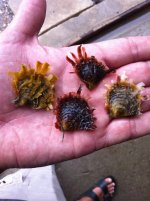
This type of shell...
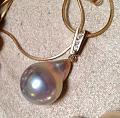
Will produce this color of pearl...

External Shell - A lot less black - more brown influence. Evolved for this environment.
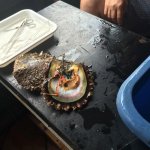
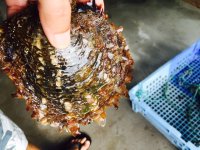
My favourites - Fiji Baroques - outside shot.
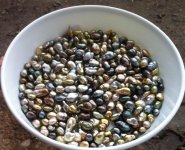
Here are some more pics. Not the fanciest, not the brightest, not the biggest, but pretty bloody cool. Love our pearls. Some of you have probably seen these before.
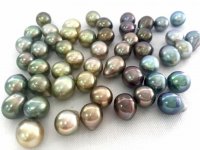
Here is some of our jewellery we produce in Fiji - all locally made (not findings) but pearls, designs, work and love.
I know, I know ..... "some of those look Tahitian" - yep they do, Yes, I know - Jorg doesn't like those. And to be honest - we get Chinese Tourists and they actually prefer the "traditional colours" - yep, its true. We will produce significantly less in the coming years.
I would like to point out the tones - If I were to describe our pearls, I think I would call them "warm / earthy".
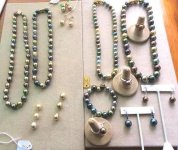
-----------
Asking about Mabe - We do, limited amounts using Peteria penquin.
We than have a pretty fantastic shell carver that works these into some pretty incredible pieces. They are pretty nice. This year we will really put some effort into this and scale this up. Shell by J. Hunter Pearls Fiji.
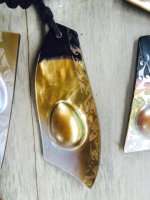
-----------
Some shots of our early auctions. These were really pretty successful - developed a bit of a "cult following" after the success of these auctions because of the unique product.
I would also talk to the invited guests about the farms, the culture of the farms, the people, and our own Environmental standards.
Here are some pics (they are not the best quality - over 5 years old).

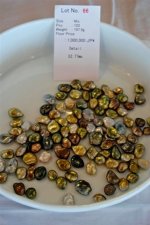
In the "early days" we always tried to balance our harvests. Our unique colours were not accepted readily into Japan - so we always produced dark pearls - as we were not 100 % sure this was not just a passing Fad.
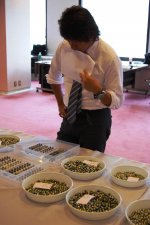
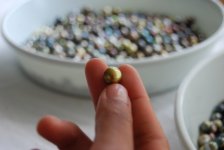
What a waste of some good pearls - that strand is ugly!
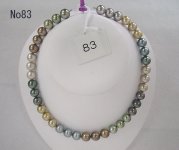
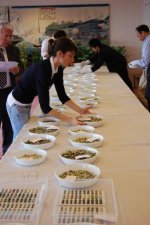
-----------
When I have a bit more time I will talk about how we start making changes to overall production, with regards to colour.. Its time to leave the darks, greys, and blacks. Sinking ship right now.
That will be a longer post this will be quick.
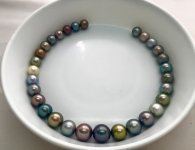
This strand we have in our safe. But it is not even finished it is actually the start of a very long process. These large pearls and their brothers and sisters will not go into multicolour strands anymore (if we can take the time and loss of $'s).
We are going to embark on a new journey - multi's seem to have a "ceiling" we are slowly and painstakingly going to start putting together single tone strands of some of our unique Fiji colours.
This will take a while - but at least we have a good number of "bigs" in the safe. So we will be building them backwards. Not sure how long it will take to get our first one completed but it will be something.
-----------
Our Pearl Guide Forum members agree! This is the first installment. Until the next, you can visit http://www.fijipearls.com to see more Fiji Pearls.
Blaire Beavers
Managing Editor
Pearl Guide News
Follow along as Justin describes pearl farming in Fiji through photographs and descriptions (taken from many of his Pearl-Guide posts):

Our shells - where the magic starts.
Our oyster is a different sub species then what is used in Tahiti. Much smaller numbers of shells - but our colours are just funky. (Actually Dr. Paul Southgate looking at the genetics of our oyster - it is unique, official findings about a year away.)
It is not easy farming pearls in Fiji.
Some of the more dramatic shells we get in.


-----------
Our Chocolate Diva
This particular pearl really stood out in our last harvest. Satin finish - large size (15mm x 17mm). Makes me smile.


Our first operation pearls average between 10.5 and 11 mm.
Because we push size we end up with circles - but they are gorgeous circles and we get a great price for them. Ill post some of our sexy circle pearls.
-----------
These shots were taken a couple years ago in Hong Kong with Jorg Gellner.
Our circles - (which some farms try not to produce) have the best colours and lustre!
These would be our "high" 10 - 11 mm rounds and circles.



-----------
The story of pearls.
We had a photographer here for the last week. Photographer got some great shots with drone. This is our hatchery - below.

Harvesting spat collectors.

Not only is income derived from pearling but also food. When we harvest our spat collectors - women usually follow behind our barge (on bamboo rafts). She is collecting edible seaweed and other shellfish. Pearling done properly is a vital industry in our rural communities.

Part of the farm - photographer looking to see how best to capture the beauty. Beautiful pearls come from some of the most beautiful places in the world. Provides income and gives value to a pristine environment.

-----------
I must admit I spent quite a bit of time reading through the Pearl Forum last night. Thoroughly impressed with some of the technical knowledge. I can definitely assist with some insight in what we produce in Fiji and why:
Fiji Oysters are very special.
Oyster supply is Fiji?s greatest constraint, It Is also its greatest asset. The size and nacre color of our oysters are key to our industry, being able to use these unique characteristics gives Fiji Pearls a special niche in the pearling world.
There are 7 different varieties of the ?Black lipped Pearl Oyster? found in the Indo ? Pacific Oceans.
- typica: Ryukyus, Taiwan, Australia, Micronesia and Melanesia
- cumingi: Cook Islands, French Polynesia
- mazalanica: Panama Bay, Baja California
- erythraensis: Red Sea
- persica: Persian Gulf
- zanzibarensis: East Africa, Madagascar, and the Seychelle Islands
- galtsoffi: Hawaiian Archipelago.
(Sims, 1993; Yukihira, et al., 1999)In the South Pacific there are two varieties:
- Pinctada magaritifera cumingi : Known as the Tahitian Black lipped pearl oyster. These are found primarily in the central Pacific Ocean. Characteristics of this oyster is its large size, dark coloration, and huge populations that thrive in atoll environments of French Polynesia. This oyster is central to Tahitian pearl production.
- Pinctada magaritifera typica: The oyster is found in the Western islands of the Pacific Ocean. It has a very broad distribution from Fiji / Australia all the way to Southern Japan. While the cumingi is known as ?the black lipped oyster? the same cannot be said for the typica which often comes in unique body and shell colorations. Note the orange body colour of the photo's of our oysters above.
- Typica is also found in relatively low numbers compared to its cousins found in the atolls.
- Typica is also a smaller oyster then the cumingi.
- They have a higher tolerance to suspended particulate matter and can be found around high islands.
Justin?s summary:
Oysters from Great Barrier reef (typica) and those from French Polynesia / Cook islands (cumingi) showed significant genetic variation. While oyster population roughly between these two subspecies of oysters showed a combination of genetics from both these subspecies. Fiji oysters naturally show a unique blend of characteristics not found in other populations.
Research we are involved in, results have shown that there are distinguishable genetic differences between orange and black colour morphs of P. margaritifera. ? Will be confirmed when study is completed.
Research we are involved in, results have shown that there are distinguishable genetic differences between orange and black colour morphs of P. margaritifera. ? Will be confirmed when study is completed.
Basically we don?t have many oysters but we have:
- Size that normal typica oyster?s do not.
- Colors that are not normally found in cumingi populations.
According to Professor Paul Southgate, a regional expert on sustainable tropical aquaculture at the University of the Sunshine Coast in Queensland, Australia, ?Fiji oysters naturally show a unique blend of characteristics not found in other populations.?
- We have been working with his students for the last couple of years, specifically genetics of our oysters.
-----------
Our farming models are different and our environment can be unforgiving. With that said, in a normal year we will harvest 35 - 40% "export grade" pearls. This is exceptionally low compared to other producers. Re-seeds will range between 10 - 20% of what we implant the previous year. We always have 4th op oysters on the farms. We have even implanted a handful of oysters 7 times! (these end up in our hatchery).
Our Colours.
I would like to say that all our pearls are chocolate and distinctly Fiji - but the truth is they are not. The technician and selected mantle tissue is critical. We use three Japanese technicians - each with over 30 years experience. Two have worked for me 15 and 12 years respectively. The 3rd - worked with us for 5 years - and I just had to let him go!!!!! Why - he could not pull the colours - too much Traditional Tahitian and silver. I have tried other technicians - disaster!! Unviable.
I can glance at a bag of harvested pearls during our harvest and know which tech made them!!!
Another nuance to our colours is that every year, every season we see slight difference in overall colours.
One point that I always try to make is that our farms are located in bays around high (relative) tropical islands. We can get pretty significant rain events that can create a huge influx of nutrients via run-off and rivers. Nutrients coming into a bay in the tropics means you are going to have a food explosion!!
Most years things are fine. But this nutrient influx, can also lead to disaster. The algal profile (food available to pearl oysters) can change quickly. Unfortunately the fastest growing algae are quite often the least nutritional. It seems that about every 5 or 6 years we see a "complete crash" of young oysters on our farms. I theorise this to be food related - either low nutritional value or even slightly toxic blooms - that kill off young oysters and stress our large shells, but does not kill them - but we do see a "decrease" in colour intensity and a high % of oysters dropping pearls way later then they should be.
Also your bacterial load (vibrio) spikes - the coup de gras. And suspended particlate matter jumps. Researchers say Pearl oysters cannot handle this, but Fiji shells can.
This year instead of 35 - 40% "export grade" - we were less then 5%). This was due to a food issue in late 2012 - early 2013. Lots of those young oysters died that year - the ones that did survive, were very weak. If young oysters are stressed - their immune systems are compromised for ever! We knew this - but 5% is better then nothing, and we focus on our own retail.
I'm not a deeply religious man - but every 5 or 6 years I spend a lot of time talking to God!!!! On the positive side - I think we can manage these events better in the future.
-----------
Just a couple more pics to get my point across from earlier. I know some of you are not quite sure.
My opinion: we make the best pearls in the world. And they are not Tahitian. And this is not my doing - Tahiti lobbied and brought in researchers for years to tell everyone that their oysters and environment were special and no one else can produce what they do - which it was and is true (P m cumungi).
Then they turned around and sold their industry to mass production - cheap Chinese labour and techs. Don't even know if any locals even work in the industry anymore (bit of a joke - but also truth to this). I hate what they have done, and I feel horrible for people like Josh (Kamoka Pearls) - who gets pushed out of what they love doing, because people pushed quantity over quality. There are middle men who are to blame also, playing one farm against another - joking among themselves about what a great deal they got, as they pay a price they know is not viable.
These farmers have mouths to feed, kids to put in school. Sorry for my rant! Here are some more pics:
Young shell - notice colours of young shell, nacre coloration can be seen in external shell.

This type of shell...

Will produce this color of pearl...

External Shell - A lot less black - more brown influence. Evolved for this environment.


My favourites - Fiji Baroques - outside shot.

Here are some more pics. Not the fanciest, not the brightest, not the biggest, but pretty bloody cool. Love our pearls. Some of you have probably seen these before.

Here is some of our jewellery we produce in Fiji - all locally made (not findings) but pearls, designs, work and love.
I know, I know ..... "some of those look Tahitian" - yep they do, Yes, I know - Jorg doesn't like those. And to be honest - we get Chinese Tourists and they actually prefer the "traditional colours" - yep, its true. We will produce significantly less in the coming years.
I would like to point out the tones - If I were to describe our pearls, I think I would call them "warm / earthy".

-----------
Asking about Mabe - We do, limited amounts using Peteria penquin.
We than have a pretty fantastic shell carver that works these into some pretty incredible pieces. They are pretty nice. This year we will really put some effort into this and scale this up. Shell by J. Hunter Pearls Fiji.

-----------
Some shots of our early auctions. These were really pretty successful - developed a bit of a "cult following" after the success of these auctions because of the unique product.
I would also talk to the invited guests about the farms, the culture of the farms, the people, and our own Environmental standards.
Here are some pics (they are not the best quality - over 5 years old).


In the "early days" we always tried to balance our harvests. Our unique colours were not accepted readily into Japan - so we always produced dark pearls - as we were not 100 % sure this was not just a passing Fad.


What a waste of some good pearls - that strand is ugly!


-----------
When I have a bit more time I will talk about how we start making changes to overall production, with regards to colour.. Its time to leave the darks, greys, and blacks. Sinking ship right now.
That will be a longer post this will be quick.

This strand we have in our safe. But it is not even finished it is actually the start of a very long process. These large pearls and their brothers and sisters will not go into multicolour strands anymore (if we can take the time and loss of $'s).
We are going to embark on a new journey - multi's seem to have a "ceiling" we are slowly and painstakingly going to start putting together single tone strands of some of our unique Fiji colours.
This will take a while - but at least we have a good number of "bigs" in the safe. So we will be building them backwards. Not sure how long it will take to get our first one completed but it will be something.
-----------
Our Pearl Guide Forum members agree! This is the first installment. Until the next, you can visit http://www.fijipearls.com to see more Fiji Pearls.
Blaire Beavers
Managing Editor
Pearl Guide News

